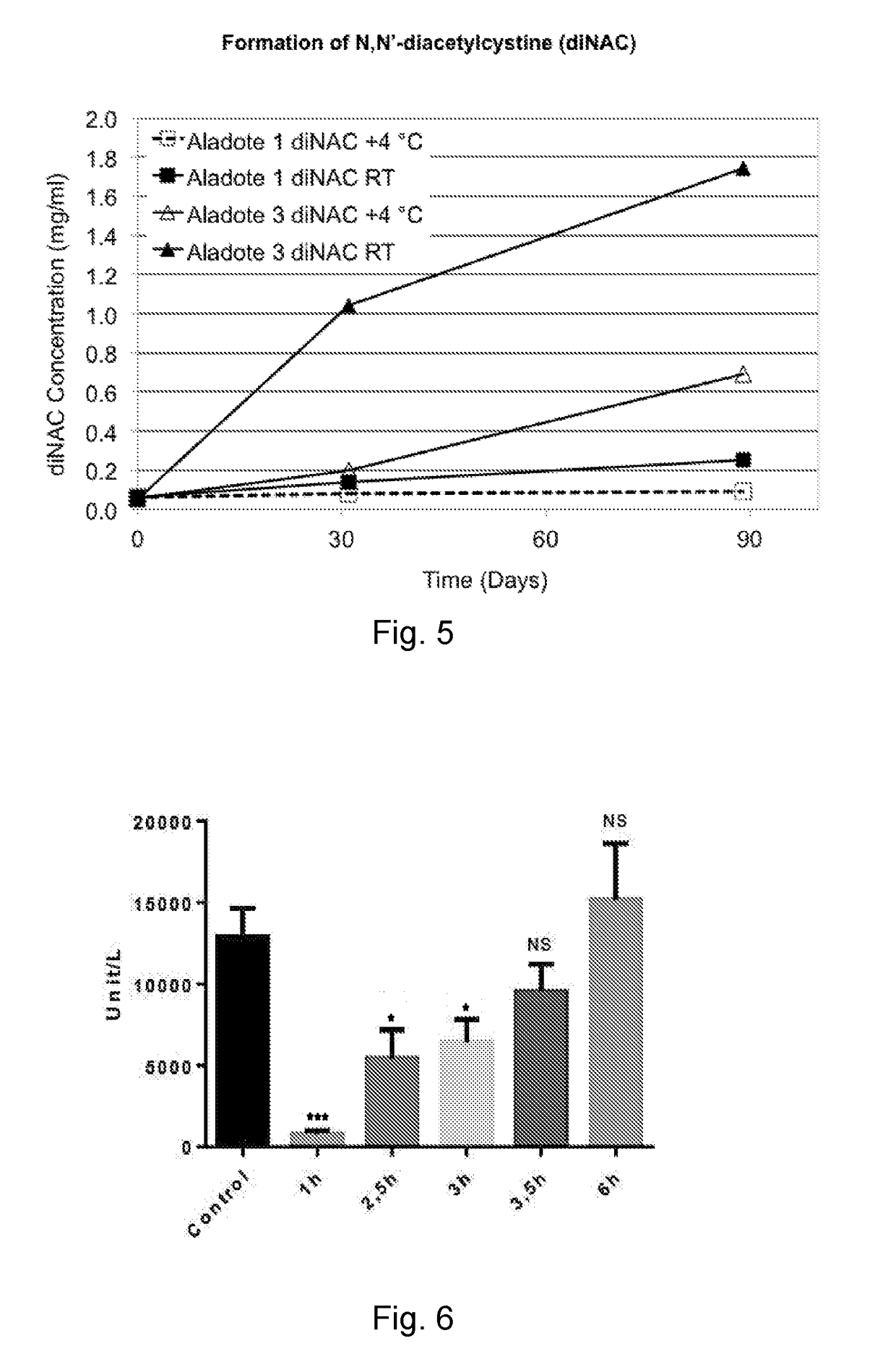Methods and formulations for treatment of and/or protection against acute liver failure and other hepatotoxic conditions
a liver failure and liver disease technology, applied in the direction of pharmaceutical delivery mechanism, organic active ingredients, drug compositions, etc., can solve the problems of inability to quickly transport patients to qualified facilities, inability to treat patients in advance, and large doses that can have disadvantageous side effects, etc., to achieve the effect of improving treatment and/or protecting against al
- Summary
- Abstract
- Description
- Claims
- Application Information
AI Technical Summary
Benefits of technology
Problems solved by technology
Method used
Image
Examples
example 1
[0058]This Example describes short and long term stability studies involving mixtures of Calmangafodipir and NAC. Each mixture was formed by adding CaM (in the form of a trisodium salt powder) and NAC to deionised water and mixing on a Vortex shaker. The solution was then transferred to an amber vial. In these studies, typically no additives or stabilizers were used. Standard degradation studies undertaken at short term used the known method of “forced” temperature degradation by storing solutions at 70° C. for 6 hours (to indicate general longer-term storage performance). Samples were withdrawn at specified time points and analyzed by standard spectroscopic methods for N-acetylcysteine (NAC), Calmangafodipir (CaM) and Calmangafodipir-related substances. The concentration of NAC remained constant during the test, suggesting that this compound should be relatively stable in solutions with CaM. CaM showed a slight decrease in concentration (about 1% per hour).
example 2
[0059]Long Term Stability Tests, involved two test mixtures. Mixture 1 comprised NAC, 10.4 mg / ml, plus CaM, 7.5 mg / ml (Mixture 1: NAC / CaM w / w ratio of 1.39) in 20 ml deionized water, and Mixture 3 comprised NAC, 10.4 mg / ml, plus CaM, 74.5 mg / ml (Mixture 3: NAC / CaM w / w ratio of 0.14). The test mixtures were studied for 3 months (90 days) at room temperature (RT, 22° C.) or 4° C. These are more realistic storage conditions for pharmaceutical products although, in the present studies, no common pharmaceutical formulation excipients were added to enhance CaM or NAC stabilization, and the storage vials were not sealed under nitrogen to reduce any effects of trapped oxygen. As such, these studies offer insight to results expected under less than optimal standard pharmaceutical storage conditions.
[0060]Concentrations of NAC and CaM were followed spectroscopically, as was the concentration of N,N″-diacetylcystine (diNAC), a self-oxidized (cystine, thiol R—S—S—R) form of NAC (R—SH).
[0061]FIG...
example 3
[0062]This Example shows ALF response to acetaminophen-induced ALF mouse model studies based on accepted acetaminophen concentrations and methodologies. In each experiment, an i.p. injection of 300 mg / kg acetaminophen was made to male B6C3F1 mice to cause acetaminophen-induced ALF. In a first experiment, a 300 mg / kg dosage of NAC was administered 1-6 hours after acetaminophen administration. In a second experiment, NAC was administered in a dosage of 30-300 mg / kg NAC 1 hour after acetaminophen administration. In a third experiment, a dosage of 0.3-10 mg / kg calmangafodipir (CaM) was administered 6 hours post acetaminophen administration. In each experiment, ALAT was measured 12 hours following the i.p. injection of 300 mg / kg acetaminophen.
[0063]FIGS. 6 to 8 show ALF response to administration of NAC and CaM, as detected by monitoring ALAT. Specifically, FIG. 6 shows Mean±SEM ALAT levels at 12 hours following the i.p. injection of 300 mg / kg acetaminophen in male B6C3F1 mice (n=4-32 pe...
PUM
| Property | Measurement | Unit |
|---|---|---|
| molar ratio | aaaaa | aaaaa |
| temperature | aaaaa | aaaaa |
| time | aaaaa | aaaaa |
Abstract
Description
Claims
Application Information
 Login to View More
Login to View More - R&D
- Intellectual Property
- Life Sciences
- Materials
- Tech Scout
- Unparalleled Data Quality
- Higher Quality Content
- 60% Fewer Hallucinations
Browse by: Latest US Patents, China's latest patents, Technical Efficacy Thesaurus, Application Domain, Technology Topic, Popular Technical Reports.
© 2025 PatSnap. All rights reserved.Legal|Privacy policy|Modern Slavery Act Transparency Statement|Sitemap|About US| Contact US: help@patsnap.com



